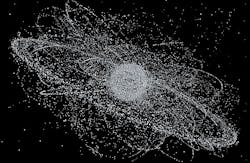Officials of the Air Force Life Cycle Management Center at Wright-Patterson Air Force Base, Ohio, have awarded a $3.9 million contract to Lockheed Martin to continue developing the NDPP under the Integrated Space Command and Control (ISC2) contract.
Related: Radar systems to monitor space junk to be designed by Northrop Grumman
ISC2 is responsible for providing air and missile warning information to the U.S. president, Joint Chiefs of Staff, and the Prime Minister of Canada if North America ever comes under attack, Lockheed Martin officials say.
In addition, ISC2 provides space situational awareness to the U.S. Strategic Command (USSTRATCOM) and Air Force Space Command from inputs from the Space Surveillance Network to track and catalog more than 23,000 space objects. The NDPP is a key step forward in exposing data to protect valuable space assets like the International Space Station.
Related: The junkyard space satellite
In 2009, the Iridium-33 communications satellite and Russia’s Kosmos-2251 military satellite collided creating a large amount of space debris. Since that time, government and commercial organizations around the globe have been working to improve space object tracking through improved collaboration.
“The cars we drive on Earth have mirrors and sensors to prevent bumps and scrapes, but if you’re trying to avoid rapidly moving debris in space, you’ll need enhanced situational awareness,” says Rob Smith, vice president of C4ISR systems with Lockheed Martin IS&GS. “Space has no national borders so it’s important to share collected data to protect all the space assets currently orbiting the planet.”
Related: Guest blog: the dilemma of finding spare electronics parts for space satellites
The NDPP system is an expansion of the ISC2 space data server, and it extends the communications infrastructure allowing operators to share data between sensor and satellite sources around the world with the Joint Space Operations Center (JSpOC) at Vandenberg Air Force Base, Calif.., company officials say. The JSpOC maintains the space object catalog that many countries depend on to safeguard the valuable investment they have in space.
NDPP will enable sensor and satellite operators around the world to share data to improve space object tracking, and give sensor and satellite operators a new tool for receiving space object catalog products.
For more information contact Lockheed Martin IS&GS online at www.lockheedmartin.com/us/isgs, or the Air Force Life Cycle Management Center at www.wpafb.af.mil/aflcmc.



